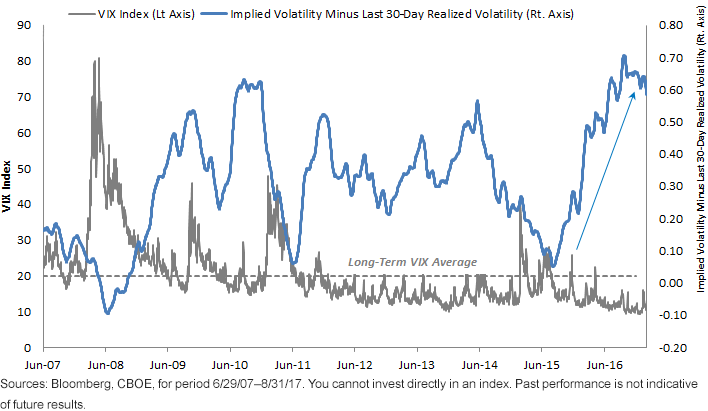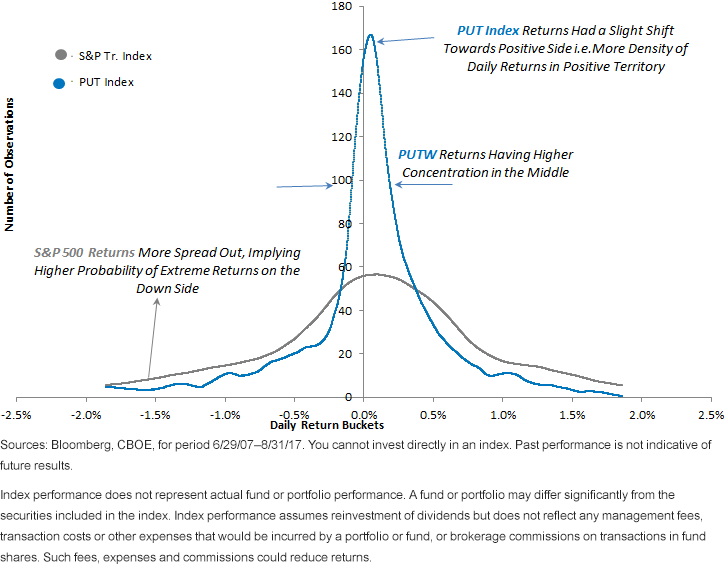Why Should I Sell Put Options in a Low-Volatility Environment?


Investors have often relied on option selling strategies to reduce volatility in their portfolios. WisdomTree’s CBOE S&P 500 PutWrite Strategy Fund (PUTW) is designed to collect premiums by selling cash-collateralized S&P 500 Index put options every month. WisdomTree believes this strategy can help reduce portfolio beta and potentially provide higher risk-adjusted returns over the long run.
Since the cost of protection—option premiums—tends to decline during periods of low volatility, one question often comes up: Is now the right time to be collecting premiums by selling puts, when volatility is so low?
My analysis below will show why sticking to the basics of investing can answer this question and help investors with the risk mitigation they look for.
Investing 101—Sell Overpriced Assets
In 2017, the S&P 500 Index is into its eighth consecutive positive year, without a negative year since 2008. Historically, a consecutive-year bull run as long as this is rare and has happened only two other times since the 1950s: 1983–1989 and 1991–1999. A sense of complacency among the investment community is natural after such long bull runs. As a result, the CBOE Volatility Index® (VIX®), a gauge of investor fear that tracks 30-day implied volatility (or markets’ expectation of the next 30-day volatility), is at its all-time low.
It is natural that in such a low-volatility environment, the cost of insuring downside—put premiums—would go down. That is what the gray line in the figure below shows. However, while VIX itself may be low, 30-day realized volatilities are even lower. In fact, the spread of VIX over trailing 30-day realized volatility has not been higher in the last 10 years.
Rising Spreads of Implied Vol Over Realized Vol Making a Case for Selling Implied Vol

This means that implied volatility (i.e., market expectation for the next 30-day volatility) is much more richly priced than realized volatility (i.e., trailing 30-day volatility). Just as buying downside protection is a bet that realized volatility would increase more than current implied volatility, selling an option is a reverse of this.
To put it simply, as long as implied volatility stays above realized volatility, people buying protection are overpaying, while people selling protection are collecting rich premiums. What matters for a strategy like PUTW, which collects put premiums every month, is for implied volatility to stay above realized volatility, making premiums that it collects richer than they ought to be.
With this logic in mind, I believe selling put options and collecting premiums in the current environment is akin to sticking to the fundamentals of investing: selling expensive, richly priced assets.
Downside Protection through Option Premiums
The CBOE S&P 500 PutWrite Index (PUT), whose performance PUTW seeks to track, before fees and expenses, has a track record of more than 10 years, and we can compared actual day-to-day returns of PUT with the S&P 500 Index. One way of doing this is bucketing returns of two indexes in various return slots and counting the number of observations corresponding to each bucket or slot.
If a strategy is less volatile, most of its returns should be concentrated in buckets closer to zero, while a more volatile strategy would see a higher number of observations in return buckets that are more extreme or far away from zero. Risk managers call this chart the distribution of returns.
Less Wide Tails of PUT Index (Historically) - Implying Better Protection for Investors

What is immediately obvious in the figure above is that:
1. PUT distribution concentrated in middle—a daily return profile that stays closer to the mean (i.e., 0)
2. S&P distribution spread out—a daily return profile that swings much more away from the mean (i.e., 0 and with fatter tails)
3. Slight right tilt of PUT distribution—a return profile with higher density of daily returns in positive territory
Conclusion
Two things to take away from the above charts:
1. Collecting premiums makes sense at a time when implied volatility is as richly priced compared to realized volatility as it has ever been.
2. Long-term distribution of PUT also indicates a return profile that was much less volatile compared to traditional index equities.
As nobody can claim to know the future, and the S&P 500 may very well continue its bull run for years to come, I do not think investors should migrate away from equities. I think investors who blend their equity holdings with PUTW can potentially not just collect income from options but reduce volatility of daily returns in their portfolios.
Important Risks Related to this Article
There are risks associated with investing, including possible loss of principal. The Fund will invest in derivatives, including S&P 500 Index put options (“SPX Puts”). Derivative investments can be volatile, and these investments may be less liquid than securities, and more sensitive to the effects of varied economic conditions. The value of the SPX Puts in which the Fund invests is partly based on the volatility used by market participants to price such options (i.e., implied volatility). The options values are partly based on the volatility used by dealers to price such options, so increases in the implied volatility of such options will cause the value of such options to increase, which will result in a corresponding increase in the liabilities of the Fund and a decrease in the Fund’s NAV. Options may be subject to volatile swings in price influenced by changes in the value of the underlying instrument. The potential return to the Fund is limited to the amount of option premiums it receives; however, the Fund can potentially lose up to the entire strike price of each option it sells. Due to the investment strategy of the Fund, it may make higher capital gain distributions than other ETFs. Please read the Fund’s prospectus for specific details regarding the Fund’s risk profile.

